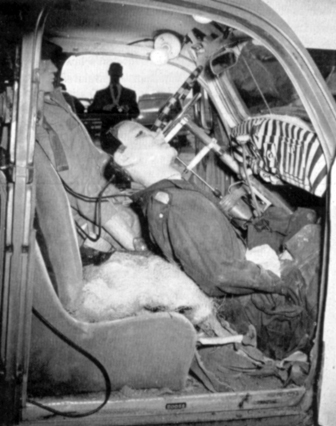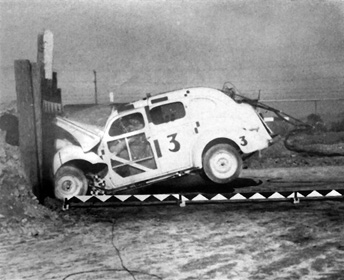Research in the field of reducing
traffic injuries is essential if this problem is ever going to be solved.
No matter how well the traffic engineer designs intersections and freeways
and regardless of the amount of money appropriated for highway safety,
accidents cannot he entirely eliminated as long as human beings are still
in the driver's seat of moving automobiles. Of course the first solution
is: Stop all motion and you stop all accidents. This is very impractical.
The next solution would appear to be one of protecting passengers against
injury due to these inevitable accidents.
Annual statistics on motorist injuries
and deaths convince us that steps should be taken to reduce the injury
toll. The Institute of Transportation and Traffic Engineering (ITTE) lias
been carrying on a crash-injury research program during the past five years
for the purpose of investigating various protective devices for occupants
in moving cars. The past four months work on this project has led to the
preparation of two carefully controlled experimental crashes which took
place last February.

| THE DUMMY in the foreground had
no protective device in this second crash. His head hit the ceiling of
the car. leaving a convex dent about an inch deep. The other dummy, protected
by a shoulder-type harness, seemed to suffer the least injury. The remote
steering motor can also be seen in this picture as well as an accelerometer
mounted on the door post. |
Under the supervision of Derwyn Severy,
project engineer, two identical 1937 automobiles were instrumented and
crashed into a rigid barrier of utility poles backed with tons of dirt.
The speed at impact was about twenty-eight miles per hour. Two anthropometric
dummies, to simulate motorists, were used in testing a total of four different
conditions of restraint. Although the instrumentation data is currently
being evaluated, preliminary observations suggest that the shoulder harness
offered the greatest crash protection followed closely by a chest level
restraint. A lap belt appeared to offer little impact protection. In fact,
essentially the same damage occurred when no restraint was used. The lap
belt does serve the purpose of holding the passenger from being thrown
from the car and would give some protection to rear seat passengers.
The dummies weighed about two hundred
pounds each and had joints with movement and fixation closely resembling
that of a person forewarned of an impending collision. An instrumented
carryall truck was used to push the car up to speed, and a one-hundred
foot electric cable joined the crash car to the instrument truck. This
cable is laid out automatically from a platform on the hood of the truck
when it slows down to a gradual stop while the crash-car coasts ahead to
hit the barrier. On top of the truck, two 110-volt AC portable power units
were kept running to supply continuous power to the floodlights in the
car, the remote controlled steering mechanism, the remote controlled push-button
brakes, and to supply power for the instruments. A twenty-four channel
recording oscillograph mounted in the instrument truck captured information
from tensiometers on the seat belts as well as the accelerometers mounted
on the various parts of the car and dummies. The photography involved in
these experiments is a major undertaking in itself. An Eastman high-speed
camera was directed on the crashing car. Moody Institute of Science cooperated
with ITTE by obtaining additional crash pictures with their high-speed
camera. A good deal of the data for the tests are contained in these films.
Not only do the pictures (taken at speeds between 1000 and 2400 frames
per second) reveal deceleration rates of the car and dummies, but also
deceleration patterns of the car frame by means of small metal targets
mounted on rods which are in turn welded at several points along the frame.
Two GSAP movie cameras mounted on the
shelf behind the back seat of the crash-car revealed additional information
on the dummies' motion during impact. Another camera located thirty feet
from the barrier panned the movement of the car and truck as they sped
toward the carrier. A similar motion picture camera mounted on top of the
instrument truck, trained forward on the car and barrier, points up steering
problems and crash behavior.
A speed graphic camera with an electronic
timing device took a still picture of the car two-hundred milliseconds
after the car first contacted the barrier. This was the time of zero forward
velocity, approximate maximum deceleration, and greatest crush-in volume.
Synchronizing the high-speed camera
with the oscillograph was accomplished by putting a strobe light on the
car within range of the camera. A detector on the front of the car opened
the circuit, turning off the strobe light and simultaneously marking a
pulse on the oscillograph record as the car contacted the barrier. Also,
the camera was modified by the provision of a metal blade on the shaft
of the camera motor which cuts the field of an electromagnet once every
ninth frame. The pulse thus generated was transmitted to the oscillograph
through a small cable dragged by the truck. Further, a standardized sixty-cycle
electrical pulse was fed into a miniature gas-filled light which was directed
against the edge of the film inside the camera to provide a time reference
used for accurately determining the film speed.
In addition to
deceleration targets on the car frame, small screws were set in the frame
at various stations. Before and after the crash, the car was placed over
a recording platform. This platform was marked using a plumb bob hung at
each of the screws. Measurements of the distances between these points
were made, and methods of triangulation can then be applied to compare
deformation of the car.

| THE SPEED of this automobile at
impact was about twenty-eight miles per hour. An electronic timer tripped
the Speed Graphic camera which took this picture 200 millseconds after
impact. This was the time of maximum deceleration and crush in volume.
The dummy, visible through the plastic door, was being protected by a chest
level restraint. The steering wheel can be seen as it was pushed by the
motor against the dummy's chest. |
After the crashes a doctor examined
the dummies for the purpose of evaluating inferred injuries and their consequences.
The unrestrained dummy did not go through the windshield as might have
been expected, but struck the top of the car leaving a dome-shaped dent
about an inch deep in the sheet metal covering. Previous crash tests suggest
that the dummies may have decelerated at as much as 20 g's.

| THE 24-CHANNEL recording oscillograph
is given a final check by Paul Niquette just before the car is pushed to
destruction. This instrument records tension in the seat belts and accelerations
of various parts of the crash-car and dummies. |
In conclusion, the objectives of these
crash injury research experiments are as follows:
-
To develop a system of instrumentation
for accurately evaluating the physical factors associated with automotive
crash deceleration.
-
Evaluation, protection-wise, of chest,
shoulder and lap type safety belts as motorist restraints.
-
Analysis of belt loadings and accelerations
of head shoulder and hip of each dummy.
-
Additional data on permanent deformation
of the car frame for a twenty-five mph. barrier crash.
-
Measurement of deceleration with respect
to time of each six inch segment of the front portion of the car frame
in order to determine the geometry of peak loadings.
-
Measurement of the longitudinal and vertical
patterns of deceleration of the intact portions of the car.
-
Provide movie films of the dynamical features
of crash deceleration of both the car and occupants for later review and
evaluation.
-
To secure additional data on pre-impact
velocity versus crush-in volume. This information may eventually lead to
the development of empirical formulas for estimating the pre-impact velocity
of wrecked vehicles.
-
To secure data on what factors lead to
injury of the unrestrained human body during a crash.
The fulfillment of these objectives may
eventually lead to much safer driving conditions for you and me.


